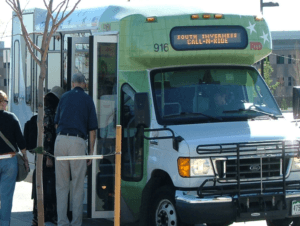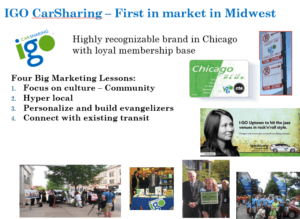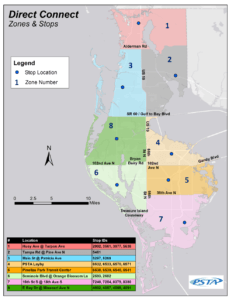Marketing Mobility on Demand Projects
20 minutes Author: Shared-Use Mobility Center Date Launched/Enacted: Jan 24, 2018 Date Published: May 30, 2018

In our discussions with Mobility On Demand (MOD) practitioners and others, we have found that marketing innovative new modes and services is a critical yet challenging piece to running a successful MOD project. In December the Shared Use Mobility Center, as part of the Federal Transit Administration’s Mobility On Demand Sandbox project, hosted a webinar “Marketing Successful Mobility on Demand Pilot Projects” that brought together both grantees and other innovators to share what they have learned as they launched their own MOD projects. SUMC’s Executive Director Sharon Feigon both moderated and shared her experience launching the successful iGo carsharing program in Chicago.

Credit: RTD
The contributors each addressed aspects of what is called the marketing mix, or the “4 Ps” of marketing: product, price, promotion, and place. The product here is often a mode that are either not known or visible to the transit users. Jeff Becker and Brian Matthews of the Regional Transportation District (Denver area) are working in a rapidly expanding region where new light rail service is reaching towards lower density suburbs. Their Call-n-Ride service, which provides a first/last mile connection to some of their more distant stations, is not visible on trip planning software. Likewise, BART’s partnership with the Scoop carpooling app. Jumana Nabti of Switchpoint Planning, which consulted on the marketing of the program with the Metropolitan Planning Commission, BART, and 511 SF Bay, tackled the idea of educating potential users about a program that would not be very visible to everyday passengers of BART. Bonnie Epstein of Pinellas Suncoast Transit Authority (PSTA) faced both the elimination of a bus route, where the vehicles and stations are visible and the route is fixed, and its replacement with transportation network companies and taxicabs, which do not have regular fixed routes and are not nearly as visible.

IGO Carshare
Pricing the service is determined by a few factors. For instance, RTD’s Lone Tree Link Shuttle is free to the users. The major employers it serves contribute the operating cost, and it is likely feasible under the understanding that the extension of the light rail line will eventually render it unnecessary. The BART pilot can use the incentive of free parking as a win-win for all. The first-last mile programs that use TNCs and taxis need to account for the cost of transit and the overall trip if it is to affect mode shift for SOV drivers and equitable access for those without a private vehicle. Even when subsidized, the TNC pricing is sensitive.

PSTA
Promotion is what the layperson traditionally thinks of when marketing comes to mind, but as we’ve seen, other considerations are just as important. That said, Sharon Feigon opened the webinar by stressing the importance of hyper-local MOD project champions, and each of the panelists shared their means of targeting these core users, as well as additional promotional strategies.
The BART project had the benefit of low-cost marketing at the stations where Scoop parking was relevant, so they used banners, A-frame placards, postcards, and digital sign announcements to spread the word about their program.
The PSTA Direct Connect project faced a bigger challenge in that it was a first/last mile connection to bus lines using TNCs, taxis, and wheelchair-accessible vehicles within two specific “geo-fenced” geographic zones. PSTA used signs with instructions, as well as flyers, but given the complexity of the early phases, they found that in-person interaction through tabling was required. They were also able to catch in the early phases some lack of familiarity with the Uber component on the part of the seniors. The RTD took advantage of their branded vehicles and instructed the drivers between trips to both park in high visibility areas with high foot traffic, such as entrances off of large parking lots, and to be available to answer questions as brand ambassadors.

BART/Scoop
It is critical to recognize the spatial aspect of the MOD program—the place—as marketing dollars are very limited, and timing is critical regardless of whether the project is a pilot or hopes to be sustainable. The PSTA Direct Connect and BART/SCOOP carpooling programs addressed immediate problems of service reductions and park-and-ride congestion. The core audience is the transit user who is affected by these problems, so transit agencies can exploit their existing spaces. However, a looming cut or service disruption means a longer lead time. The BART program was able to further target the stations with the most need, and monitor those stations for performance. On the other hand, the RTD programs, in addition to getting current users of the Call-n-Ride, added Lyft and found that regular Call-n-Ride service maintained its user base, while occasional/spontaneous users opted more for the Lyft program. The RTD shuttles and iGo cars rely heavily on the vehicles themselves.